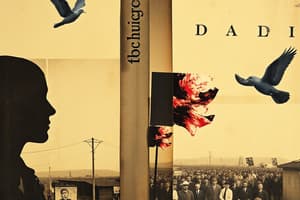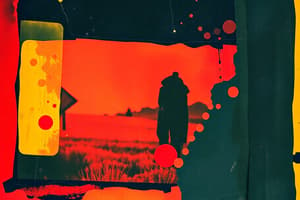Podcast
Questions and Answers
What was the important discovery made by Joseph Nicéphore Niépce?
What was the important discovery made by Joseph Nicéphore Niépce?
The first photograph.
What was the first photographic image?
What was the first photographic image?
View from the Window at Le Gras
Who made the first successful photograph?
Who made the first successful photograph?
Joseph Nicéphore Niépce
Who is credited with the invention of the camera obscura?
Who is credited with the invention of the camera obscura?
What is the name of the process of using sunlight, a camera obscura, and a light-sensitive substance to create an image?
What is the name of the process of using sunlight, a camera obscura, and a light-sensitive substance to create an image?
What is the main difference between the camera obscura and the camera?
What is the main difference between the camera obscura and the camera?
Who was Johann Heinrich Schulze?
Who was Johann Heinrich Schulze?
What was found in the laboratory of Schulze?
What was found in the laboratory of Schulze?
What is the name of the artist who was known for his experimental photography?
What is the name of the artist who was known for his experimental photography?
What did Wedgwood use to create images?
What did Wedgwood use to create images?
What was the substance that Wedgwood used to create his images?
What was the substance that Wedgwood used to create his images?
What is the name of the material that is sensitive to light?
What is the name of the material that is sensitive to light?
What was the difference between the camera obscura and what Wedgwood experimented with?
What was the difference between the camera obscura and what Wedgwood experimented with?
Who is known for recording the first permanent photographic image?
Who is known for recording the first permanent photographic image?
What is the name of the first permanent photograph?
What is the name of the first permanent photograph?
What was the first type of photography discovered?
What was the first type of photography discovered?
What was the name of the process used to create the first permanent photograph by Niépce?
What was the name of the process used to create the first permanent photograph by Niépce?
What is the name of the process that Niépce used to create the first permanent photograph?
What is the name of the process that Niépce used to create the first permanent photograph?
What is the name of the process that was used by Niépce to create the first permanent photograph?
What is the name of the process that was used by Niépce to create the first permanent photograph?
What was Niépce's invention called?
What was Niépce's invention called?
What process involves using light-sensitive materials to capture an image?
What process involves using light-sensitive materials to capture an image?
Who was Louis Daguerre?
Who was Louis Daguerre?
What is the name of the first successful photographic process that was able to produce images that were not faded and could be copied?
What is the name of the first successful photographic process that was able to produce images that were not faded and could be copied?
What is the name of the photographic process developed by Daguerre?
What is the name of the photographic process developed by Daguerre?
What is the name of the photographic process developed by Daguerre that used a light-sensitive silver-plated copper sheet?
What is the name of the photographic process developed by Daguerre that used a light-sensitive silver-plated copper sheet?
Who was the first person to use photographic paper for printing?
Who was the first person to use photographic paper for printing?
What is the name of the process that was developed by Talbot?
What is the name of the process that was developed by Talbot?
What makes the calotype process different from other photography methods?
What makes the calotype process different from other photography methods?
Flashcards
Angelo Sala's discovery
Angelo Sala's discovery
Silver nitrate blackened when exposed to light.
Johann Schulze's contribution
Johann Schulze's contribution
Showed light caused silver chloride to darken, not heat.
Thomas Wedgwood's experiment
Thomas Wedgwood's experiment
Tried making images with camera obscura, but results were not perfect.
Wedgwood's negative images
Wedgwood's negative images
Signup and view all the flashcards
Humphrey Davy's experiments
Humphrey Davy's experiments
Signup and view all the flashcards
Niépce's 1824 image
Niépce's 1824 image
Signup and view all the flashcards
Heliogravure
Heliogravure
Signup and view all the flashcards
Camera Obscura
Camera Obscura
Signup and view all the flashcards
17th century discovery
17th century discovery
Signup and view all the flashcards
18th century refinement
18th century refinement
Signup and view all the flashcards
Early photographic attempts
Early photographic attempts
Signup and view all the flashcards
Unsuccessful results
Unsuccessful results
Signup and view all the flashcards
First lasting image
First lasting image
Signup and view all the flashcards
Pewter plate
Pewter plate
Signup and view all the flashcards
Asphalt
Asphalt
Signup and view all the flashcards
8-hour exposure
8-hour exposure
Signup and view all the flashcards
Lithography
Lithography
Signup and view all the flashcards
Image recording
Image recording
Signup and view all the flashcards
1800s Photography Development
1800s Photography Development
Signup and view all the flashcards
French Lithographer
French Lithographer
Signup and view all the flashcards
Study Notes
Early Photography
- Italian scientist Angelo Sala discovered silver nitrate darkened in sunlight in the 17th century.
- German professor Johann Heinrich Schulze in 1712 demonstrated darkening of silver chloride by light in experiments.
- This showed light could darken silver compounds, a crucial step in photographic development.
Thomas Wedgwood's Experiments
- English scientist Thomas Wedgwood (around 1800) experimented with recording images using camera obscura.
- His efforts to capture images were unsuccessful in producing permanent prints.
- He focused on making negative images, a significant step in the progress of photography.
Humphrey Davy's Work
- English scientist Humphrey Davy continued with silver chloride experiments.
- Similar to Schulze, his results using silver chloride weren't permanent.
Nicéphore Niépce's Breakthrough
- French lithographer Nicéphore Niépce (around 1824) successfully created a relatively permanent image.
- He used a camera obscura and a pewter plate coated with asphalt to produce his first image. This is the Heliogravure process.
- This process is similar to lithography.
1826 - Further Development
- Nicéphore Niépce, in 1826, experimented further, attempting to produce a print.
Studying That Suits You
Use AI to generate personalized quizzes and flashcards to suit your learning preferences.




